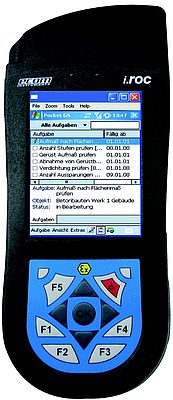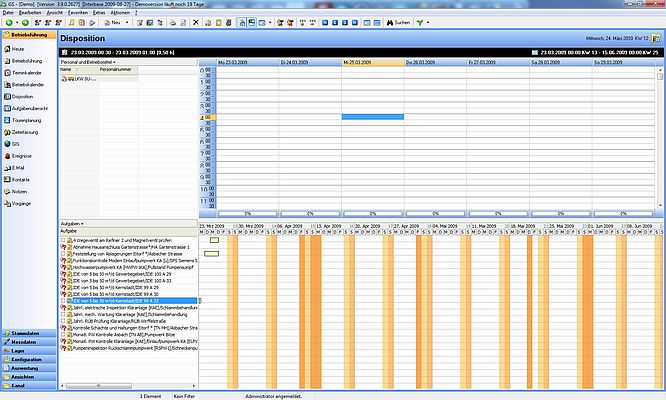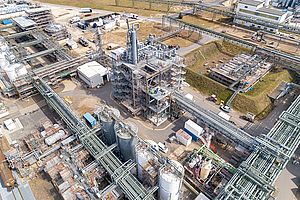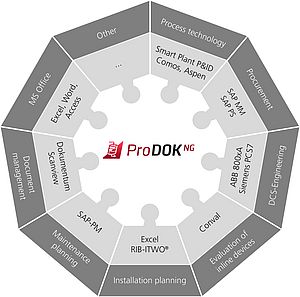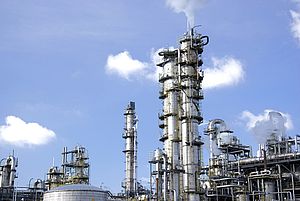The cost pressure in the process industry is high. Companies have to run their plants with maximum efficiency. This is not just a question of avoiding expensive downtimes, but also of identifying less obvious cost drivers.
In the everyday practice of plant management and maintenance there are many of these less obvious cost drivers, but frequently ERP (Enterprise Resource Planning) systems with maintenance modules do not offer sufficient support in identifying optimization potential. Nor do they provide enough scheduling assistance for maintenance engineers – although it is in the optimization of work organization, combined with more operational safety and reliability, that many saving potentials can be found.
A businessman’s view of plant management and maintenance naturally differs from that of a maintenance engineer. Whereas the former is more interested in the economic angle, for the latter it is organizational process planning which occupies the foreground. Particularly in large firms, maintenance orders are also drawn up using ERP systems. However, not only are these systems generally inflexible, they also generate tasks for the engineer or foreman responsible for maintenance organization, which have little to do with his core competences. Instead of actually planning and carrying out maintenance work, he has to busy himself with a whole lot of system-related work.
For the actual planning of maintenance work, ERP systems, which are very statically structured, have little support to offer. This is equally true for general planning (of what maintenance work needs to be carried out, and when) and for the planning of safety-relevant inspections. Since in most cases no support is provided in coping with unplanned maintenance work either, engineers have to improvise each time an unexpected event occurs, if it is too urgent to wait till the next planning date. Optimal workflows, ideal deployment of personnel, machines and resources cannot be attained with systems of this kind.
Scheduling Made Easy
Tools which are specially designed with plant and maintenance planning in mind, such as GS Service can give relief here. They are explicitly adapted to the requirements of maintenance planners. They can be used very simply to plan both regular and spontaneous maintenance work. For this purpose, the whole plant is represented as a system of objects. An object may be a whole building, a part of a plant such as e.g. a boiler, or one individual component, e.g. a pump. The structure of the objects to be managed can be hierarchically plotted, to any depth. The system also stores other information: employees, together with their competences and their working hours; rules for dealing with spontaneous maintenance tasks; the working materials, tools and spare parts needed for specific tasks. Additionally, the resource, device and tool administration gives an overview of the status of all equipment and tools required for maintenance work.
Keeping an Overview – at All Times
For management purposes, a plant operator wants to know at all times what tasks are upcoming, but also which of the assignments that have been carried out. To be able to plan sensibly, managers need to know which regular maintenance tasks have to be performed, and when. It has to be possible to coordinate the status of the plant with its maintenance requirements so that, for instance, certain maintenance tasks can be carried out exactly at a time when a machine is not producing. Also essential for reasonable planning is a clear view of which inspection dates are overdue, and which can be put back without endangering plant availability. Moreover, there is a legal requirement for complete documentation of all maintenance and plant management measures when examining liability for failures and accidents.
Another important aspect of plant management is cost and budget management. How much time and money will specific maintenance jobs require? Here, a cost center can be assigned to each object. In this way, costs that have arisen over a freely selectable period of time can be classified by cost center, object or other criteria.
Various Standard Reports enable factually-based, up-to-date statements on all relevant areas such as plant history, order situation and cost structure to be accessed at any time. As well as the Standard Reports, however, individual requests can also be submitted. The manifold possible combinations of a wide range of evaluations not only enable statements to be made about the present status of the plant – they also help to identify trends, thus allowing users to ‘look into the future’.
Flexible, Thanks to Mobile Devices
In many factories, paper lists are still printed out for the planning of maintenance work and distributed. If this arrangement is interfered with by spontaneous maintenance tasks, these can only be integrated into the current workflow with a great loss of effectiveness. However, with a planning system it is very simple to ascertain which worker is the vicinity of the unexpected trouble spot. If maintenance workers receive their lists electronically, for instance on a PDA (personal digital assistant), the person responsible for the scheduling of maintenance work can simply and flexibly assign tasks.
Measured values and changes can be entered directly in the PDA, and if necessary transmitted to the system straight away, e.g. by WLAN. This not only saves time but enhances the quality of the data, as the deciphering and typing of handwritten information is always inherently error-prone. All plant data are substantially more up-to-date and there is also the additional benefit of greater legal security, as at any time it is possible to trace who performed a repair, the nature of the repair, and when it was carried out.
Further Benefits Included
For maintenance to function smoothly, the necessary spare parts have to be there. In most cases, no system is used to support spare parts management. To be sure of reserves in an emergency, spare parts are acquired on the “more is better” principle. Thus quantities of expensive spare parts which are not going to be needed accumulate in store. Here, too, appropriate inventory administration functions embedded in a plant management and maintenance system can help. For one thing, they give an instant overview of the spare parts that are actually there. For another, spare parts procurement can be approached quite differently in combination with a plannable maintenance management system.
Conclusions
Software tools for plant management and maintenance help to identify hidden costs and optimize processes. They not only cut down maintenance costs but also increase plant availability. Systems like GS Service can be used as a ‘stand-alone’ solution or linked with external systems such as e.g. SAP, distributed control systems and geo-information systems. In this way, all the data necessary for the smooth operation of a plant are centrally available. The use of mobile devices considerably enhances maintenance flexibility, while also substantially improving data quality. Classic areas of application are to be found in the broad field of process technology. However, since plants of all kinds can be mapped with this system, more exotic fields of application can be envisaged. Purchasing a system of this kind is cost-effective even for small and medium-sized firms. Generally a return on investment can be expected within two years at latest; after that, the system saves money all the time.
Plant management & maintenance
for the process industry
- by Rösberg Engineering Ingenieurgesellschaft mbH
- September 1, 2010
- 7591 views


